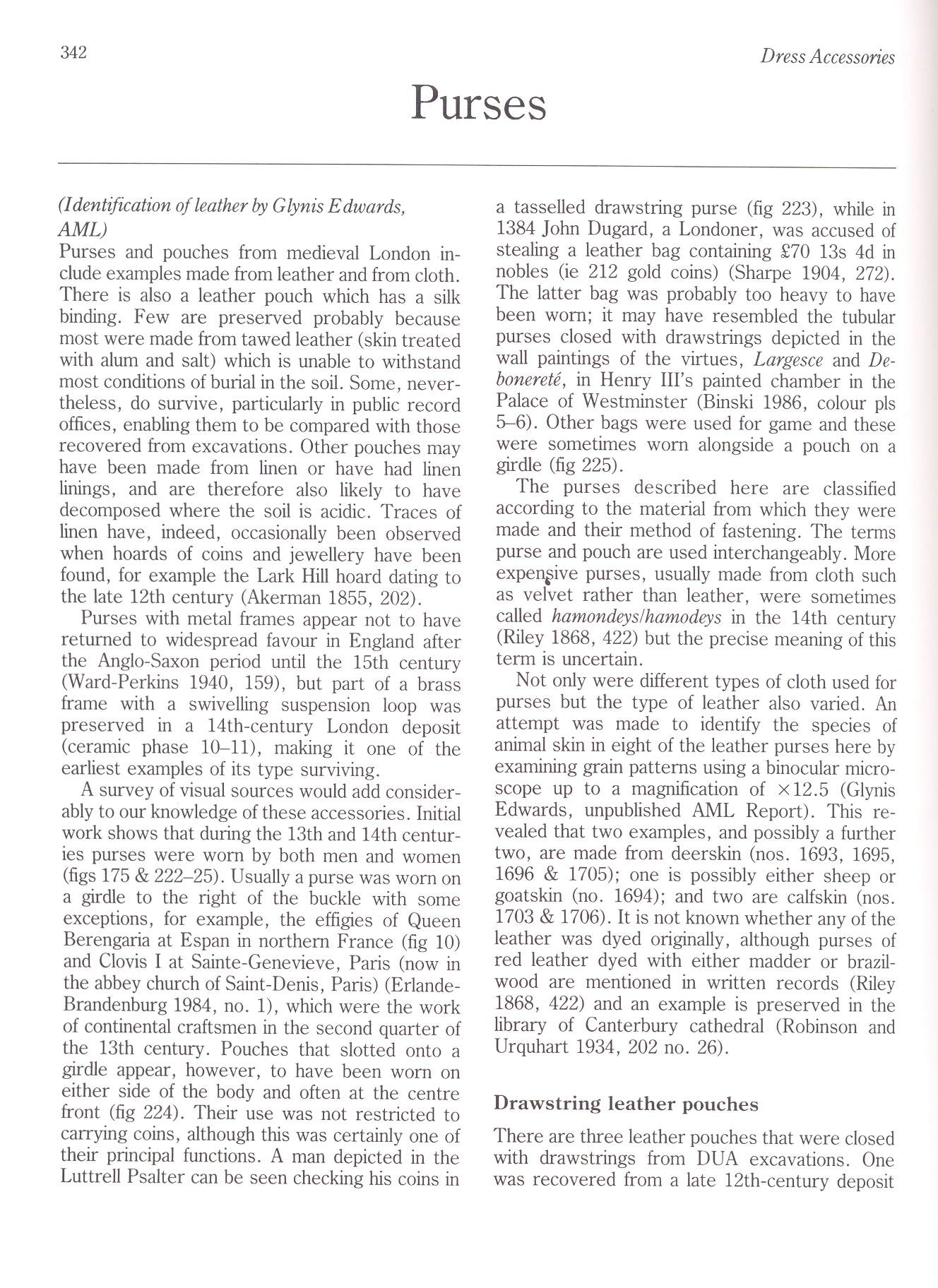369 (15)

342
Dress Accessońes
Purses
(Identification of leather by Glynis Edwards,
AMD
Purses and pouches from medieval London in-clude examples madę from leather and from cloth. There is also a leather pouch which has a silk binding. Few are preserved probably because most were madę from tawed leather (skin treated with alum and salt) which is unable to withstand most conditions of burial in the soil. Some, never-theless, do survive, particularly in public record offices, enabling them to be compared with those recovered from excavations. Other pouches may have been madę from linen or have had linen linings, and are therefore also likely to have decomposed where the soil is acidic. Traces of linen have, indeed, occasionally been observed when hoards of coins and jewellery have been found, for example the Lark Hill hoard dating to the late 12th century (Akerman 1855, 202).
Purses with metal frames appear not to have retumed to widespread favour in England after the Anglo-Saxon period until the 15th century (Ward-Perkins 1940, 159), but part of a brass frame with a swivelling suspension loop was preserved in a 14th-century London deposit (ceramic phase 10-11), making it one of the earliest examples of its type surviving.
A survey of visual sources would add consider-ably to our knowledge of these accessories. Initial work shows that during the 13th and 14th centur-ies purses were wom by both men and women (figs 175 & 222-25). Usually a purse was wom on a girdle to the right of the buckie with some exceptions, for example, the effigies of Queen Berengaria at Espan in northem France (fig 10) and Clovis I at Sainte-Genevieve, Paris (now in the abbey church of Saint-Denis, Paris) (Erlande-Brandenburg 1984, no. 1), which were the work of Continental craftsmen in the second ąuarter of the 13th century. Pouches that slotted onto a girdle appear, however, to have been wom on either side of the body and often at the centre front (fig 224). Their use was not restricted to carrying coins, although this was certainly one of their principal functions. A man depicted in the Luttrell Psalter can be seen checking his coins in a tasselled drawstring purse (fig 223), while in 1384 John Dugard, a Londoner, was accused of stealing a leather bag containing £70 13s 4d in nobles (ie 212 gold coins) (Sharpe 1904, 272). The latter bag was probably too heavy to have been wom; it may have resembled the tubular purses closed with drawstrings depicted in the wali paintings of the virtues, Largesce and De-bonerete, in Henry III’s painted chamber in the Pałace of Westminster (Binski 1986, colour pis 5-6). Other bags were used for gamę and these were sometimes wom alongside a pouch on a girdle (fig 225).
The purses described here are classified according to the materiał from which they were madę and their method of fastening. The terms purse and pouch are used interchangeably. Morę expen£ive purses, usually madę from cloth such as velvet rather than leather, were sometimes called hamondeyslhamodeys in the 14th century (Riley 1868, 422) but the precise meaning of this term is uncertain.
Not ordy were different types of cloth used for purses but the type of leather also varied. An attempt was madę to identify the species of animal skin in eight of the leather purses here by examining grain pattems using a binocular micro-scope up to a magnification of xl2.5 (Glynis Edwards, unpublished AML Report). This re-vealed that two examples, and possibly a further two, are madę from deerskin (nos. 1693, 1695, 1696 & 1705); one is possibly either sheep or goatskin (no. 1694); and two are calfskin (nos. 1703 & 1706). It is not known whether any of the leather was dyed originally, although purses of red leather dyed with either madder or brazil-wood are mentioned in written records (Riley 1868, 422) and an example is preserved in the library of Canterbury cathedral (Robinson and Urąuhart 1934, 202 no. 26).
Drawstring leather pouches
There are three leather pouches that were closed with drawstrings from DUA excavations. One was recovered from a late 12th-century deposit
Wyszukiwarka
Podobne podstrony:
302 (41) 274 Dress Accessońes buttons of the former kind, found in Lund in Sweden). Composite sheeti
kolibry w malwach (1) SORT YOUR COLORS Identify your colors by comparing them in daylight and checki
352 (30) 325Finger rings (Identification of gemstones by Marjorie Hutchinson and Roger Harding) The
415 (8) 388 Dress Accessories electron microscope (SEM) using a 20 keV accelerating voltage and Link
Zaproszenie Do Socjologii PDF eBooks Download of Communism by ex-Communist Whittaker Chambers, and a
257 (39) 228 1218 i 1222 Dress Accessories 142 Eyelets(lrl) In same finds bag was acc. no. 801E - pa
274 (42) Dress Accessońes 246 1078 805 1095 (A) mounts with fields of dots (1:1) (
276 (40) 248 Dress Accessońes because no indication has been recognized on them of the wearer’s adhe
329a 302 Dress Accessories 201 Pins with different forms of solid heads from a&nbs
420 (12) 393Metallurgical Analysis of the Dress Accessories Lead Lead Fig 266 Copper alloys c. 1270-
422 (13) Metallurgical Analysis of the Dress Accessories site form which include a forked spacer san
425 (10) 398 Dress Accessories surfaces. Many objects had evidence of tin coat-ing (colour pis 4G &a
427 (11) 400 Dress AccessoriesAcknowledgements In a work of tliis size and comp!exity the principal
431 (10) 404 Dress Accessońes —, 1987 ‘Report on the Composition of the Ingots and Axle-Cap’, in Mea
359 (16) 332 Dress Accessońes which to produce a finger ring, it is not a solitary example. Another
371 (18) 344 Dress Accessories (ceramic phase 6), another from a deposit of the late 13th or early 1
375 (18) 348 Dress Accessońes ribbon was then hemmed to the back of the pouch and the other oversewn
więcej podobnych podstron